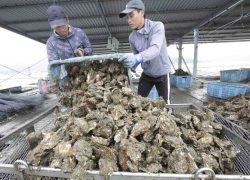16:13 JST, August 2, 2023
PARIS (AFP-Jiji) — The “Ivory Man,” whose remains were found in an opulent tomb in Spain in 2008, is believed to have been the most powerful and influential person of his ancient society nearly 5,000 years ago.
There’s just one problem: the remains are of a woman, scientists have revealed.
They have renamed her the “Ivory Lady.”
Human remains are one of the only ways to understand the balance of power between the genders in ancient societies.
But it is often difficult to determine whether poorly preserved skeletons are those of men or women.
Even DNA can be difficult to extract from remains found in hot and dry climates such as Iberia, now modern day Spain and Portugal.
At a vast archaeological site at Valencina, near the southwestern Spanish city of Seville, several large and sophisticated tombs have been unearthed.
They date back to 2,900-2,650 B.C., in a period known as the Copper Age.
Mass burials were the norm for this ancient Iberian society, but in 2008 archaeologists discovered a tomb containing just one person.
A standard physical examination at the time determined the person was a male between 17 and 25 years old, according to a study published in the journal Scientific Reports last month.
Lavish artifacts were found at the person’s side.
They included a large ceramic plate that showed chemical traces of wine and cannabis, a complete elephant tusk and many objects made of ivory — earning the person the nickname the “Ivory Man.”
The treasure trove suggested that the young person was “the most socially prominent” person in Iberia from 3,200 to 2,500 B.C., the study said.
After years of studying this person, a team of researchers decided to find out if he was in fact male.
They used a new technique to test for a protein in the person’s teeth called amelogenin, which differs between the genders.
What they found “came as a surprise,” said the study’s lead author, Marta Cintas Pena of Spain’s University of Seville.
The Ivory Man was a woman.
“To be completely sure, we sent a second tooth, and the analysis confirmed the first results,” she told AFP.
The researchers pointed out that the Ivory Lady’s tomb was close to a collective mortuary containing 15 women and similar ivory artifacts dating from a couple of generations later.
No male has been found buried in similar splendor in Valencina.
That there were no infant burials at the site suggested that the Ivory Lady achieved her lofty social position and power through “merit and personal achievement and did not ‘inherit’ it by birth,” the study suggested.
Cintas Pena said that ancient societies are often considered to have been led by men, but her research “shows that this was not necessarily the case.”
“This implies that we need not only to rethink what has been said for Copper Age Iberia but for the processes that led to social complexity worldwide.”
However French archaeologist Anne Augereau, who was not involved in the study, said to beware the “myth of primitive matriarchy.”
“No matriarchal society has been undeniably identified to date,” she told AFP.
"Science & Nature" POPULAR ARTICLE
-

Mass Oyster Die-Offs Confirmed in Japan’s Seto Inland Sea; High Water Temperature Cited as Primary Cause
-

Genome Study Reveals Milestone in History of Cat Domestication
-

Big Leap in Quest to Get to Bottom of Climate Ice Mystery
-

Security Camera Footage Vulnerable to Outside Access; Investigation Finds 3,000 Pieces Exposed Online
-

Paws on Parade: Nairobi’s Dogs Dazzle at ‘Pawchella’
JN ACCESS RANKING
-

Keidanren Chairman Yoshinobu Tsutsui Visits Kashiwazaki-Kariwa Nuclear Power Plant; Inspects New Emergency Safety System
-

Imports of Rare Earths from China Facing Delays, May Be Caused by Deterioration of Japan-China Relations
-

University of Tokyo Professor Discusses Japanese Economic Security in Interview Ahead of Forum
-

Japan Pulls out of Vietnam Nuclear Project, Complicating Hanoi’s Power Plans
-

Govt Aims to Expand NISA Program Lineup, Abolish Age Restriction























